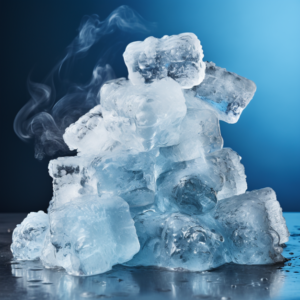Ready to take your recovery to the next level? Look no further than the ice bath, a technique favored by athletes and fitness enthusiasts alike. But do you know what the perfect temperature is for an ice bath? Don’t worry, we’ve got you covered. In this article, we’ll dive into the ideal temperature range for reaping the maximum benefits of an ice bath, helping you boost your recovery and achieve your fitness goals. So, get ready to take the plunge and discover the secrets behind the perfect temp for an ice bath!

Benefits of Ice Baths
Reducing muscle soreness
Ice baths have been known to effectively reduce muscle soreness after intense workouts or physical activities. The cold temperature helps alleviate inflammation and reduce the buildup of lactic acid in the muscles. By soaking in an ice bath, you can help relieve the discomfort and stiffness that often accompany muscle soreness, allowing you to recover more quickly and get back to your regular training routine.
Enhancing muscle recovery
Ice baths are commonly used by athletes to enhance muscle recovery. The cold temperature helps constrict blood vessels, which reduces swelling and inflammation in the muscles. This, in turn, helps improve circulation and oxygen flow to the damaged muscle fibers, allowing them to repair and regenerate more efficiently. By incorporating ice baths into your recovery routine, you can speed up the healing process and minimize the risk of muscle damage.
Improving circulation
Another benefit of ice baths is their ability to improve circulation throughout the body. When you immerse yourself in cold water, your blood vessels constrict, forcing the blood to circulate more efficiently. As a result, your body is better able to deliver oxygen and nutrients to the muscles, organs, and other tissues, promoting overall health and well-being. Improved circulation can also aid in the removal of waste products from the body, helping to detoxify and rejuvenate your system.
Reducing inflammation
Ice baths are well-known for their anti-inflammatory effects. The cold temperature causes blood vessels to constrict, which can reduce inflammation and swelling in the body. This can be particularly beneficial for individuals with conditions such as arthritis or injuries that involve inflammation. By incorporating ice baths into your routine, you can help manage inflammation and potentially alleviate associated pain and discomfort.
Factors to Consider
Individual tolerance
When it comes to ice baths, individual tolerance plays a crucial role. Some people may find it difficult to tolerate the cold temperature of an ice bath, while others may have a higher threshold. It is important to assess your own tolerance level and gradually increase the duration and intensity of your ice bath sessions over time. It is also advisable to consult with a healthcare professional or qualified coach to determine the most appropriate approach for you.
Duration of ice bath
The duration of your ice bath session is another important factor to consider. While shorter sessions can still provide benefits, longer sessions are generally more effective in reducing muscle soreness and enhancing recovery. Start with shorter durations, such as five minutes, and gradually increase the time up to 15 minutes or as tolerated. It is important to listen to your body and never exceed your comfort level.
Post-workout goals
Your post-workout goals should also be taken into account when deciding whether to incorporate ice baths into your routine. If your goal is to reduce muscle soreness and enhance recovery, ice baths can be highly beneficial. However, if your goal is to promote muscle growth and hypertrophy, you may want to reconsider the use of cold therapy, as it has been shown to potentially interfere with the signaling pathways involved in muscle adaptation.
Specific injuries or conditions
If you have specific injuries or medical conditions, it is important to consult with a healthcare professional before incorporating ice baths into your routine. While ice baths can be beneficial for many individuals, they may not be suitable for everyone. Certain conditions, such as Raynaud’s disease or cold urticaria, may be contraindicated for cold exposure. It is important to prioritize your health and safety when considering ice baths.

Recommended Temperature Range
Approximately 50-59°F (10-15°C)
The recommended temperature range for ice baths is approximately 50-59°F (10-15°C). Within this range, the water is cold enough to provide the desired therapeutic effects without being excessively cold. This temperature range allows for optimal muscle recovery and reduces the risk of hypothermia or frostbite.
Around 59-68°F (15-20°C)
For individuals who find the lower temperature range too intense, a slightly warmer option of around 59-68°F (15-20°C) can be chosen. This range still provides many of the benefits associated with ice baths, albeit to a slightly lesser degree. It is important to find a temperature range that is comfortable for you while still providing the desired effects.
Between 68-77°F (20-25°C)
If you prefer a milder approach or have a lower tolerance for the cold, a temperature range of between 68-77°F (20-25°C) can be utilized. While this may not have the same intense cooling effects as colder temperatures, it can still provide some benefits in terms of muscle recovery and circulation enhancement.
Above 77°F (25°C)
Temperatures above 77°F (25°C) are typically not recommended for ice baths. At higher temperatures, the cooling effects are minimal, and the therapeutic benefits are significantly reduced. While soaking in warmer water can still be enjoyable and relaxing, it may not offer the same benefits as a cold water immersion.
Importance of Thermoregulation
Maintaining body core temperature
One of the key considerations when taking ice baths is thermoregulation. The body has a natural ability to maintain its core temperature within a narrow range. When exposed to cold water, the body starts to lose heat rapidly, causing a decrease in its core temperature. By being mindful of thermoregulation and not allowing the core temperature to drop excessively, you can enjoy the benefits of ice baths while minimizing the risk of hypothermia.
Avoiding hypothermia
Hypothermia is a potentially dangerous condition that occurs when the body loses heat faster than it can produce it, resulting in a dangerously low core temperature. To avoid hypothermia during ice baths, it is important to monitor your body’s response to the cold and take precautions to prevent excessive cooling. This includes limiting the duration of your ice bath sessions and ensuring that your core temperature remains within a safe range.
Preventing frostbite
Frostbite is a condition that occurs when the skin and underlying tissues freeze due to prolonged exposure to freezing temperatures. It is important to prevent frostbite during ice baths by ensuring that your skin is not in direct contact with ice or extremely cold surfaces. It is advisable to wear appropriate clothing, such as swimwear or athletic gear, and use a bath mat or towel to provide a barrier between your body and the cold water.

This image is property of images.pexels.com.
Precautions and Safety Measures
Gradual temperature adjustment
To avoid shock to your system, it is important to gradually adjust the temperature of the ice bath. Start with lukewarm water and gradually add ice or cold water to reach the desired temperature. This gradual adjustment allows your body to acclimate to the cold and reduces the risk of a sudden drop in core temperature.
Limiting ice bath duration
While longer ice bath sessions can provide greater benefits, it is essential to listen to your body and not exceed your limits. Start with shorter durations, such as five minutes, and gradually increase the time as tolerated. It is more important to maintain a safe core temperature and avoid prolonged exposure to cold than to push through discomfort for extended periods.
Avoiding full body immersion
It is generally recommended to avoid full-body immersion in ice baths, especially for prolonged periods, as this can increase the risk of hypothermia and frostbite. Instead, focus on immersing the target areas, such as legs or specific muscle groups, while keeping the rest of your body comfortably warm. This targeted approach allows you to receive the benefits of the ice bath without subjecting your whole body to prolonged cold exposure.
Alternatives to Ice Baths
Cold water immersion
If you do not have access to an ice bath, cold water immersion can be a viable alternative. Fill a bathtub or a large container with cold water, and immerse the target areas or your whole body for the desired duration. While it may not provide the exact same benefits as an ice bath, cold water immersion can still help reduce muscle soreness and provide some of the therapeutic effects associated with cold therapy.
Cryotherapy
Cryotherapy involves exposing the body to extremely cold temperatures for a brief period, typically ranging from two to four minutes. This can be achieved using specialized cryo chambers or cryotherapy machines. While cryotherapy may offer similar benefits to ice baths, such as reduced inflammation and enhanced recovery, it is important to be aware of the potential risks and consult with a healthcare professional before incorporating cryotherapy into your routine.
Topical cold therapy
Topical cold therapy, such as ice packs or cold compresses, can be used to target specific areas of the body. This approach is particularly useful for localized injuries or sore muscles. Applying cold therapy to the affected area for short intervals can help reduce inflammation and alleviate pain. Topical cold therapy can be a convenient and easily accessible alternative to full-body ice baths or cold water immersion.

Tips for Maximizing Ice Bath Benefits
Active recovery exercises
Incorporating active recovery exercises into your ice bath routine can amplify the benefits. Gentle movements, such as light stretching or low-intensity exercises, while immersed in the cold water can help increase blood flow and enhance the overall recovery process. These exercises promote muscle relaxation and mobility, making them a valuable addition to post-workout ice baths.
Contrasting hot and cold therapy
Contrasting hot and cold therapy involves alternating between hot water and cold water or heat and ice treatments. This technique can enhance the benefits of ice baths by promoting vasodilation and vasoconstriction. Start with an ice bath for a few minutes, followed by a warm shower or soak in a hot tub. Repeat this cycle a few times, ending with cold therapy. The contrasting temperatures can help improve circulation, reduce muscle soreness, and promote overall relaxation.
Proper hydration and nutrition
Staying properly hydrated and maintaining a balanced diet are essential for maximizing the benefits of ice baths. Hydration plays a crucial role in maintaining circulation and overall cellular function. By drinking enough water before and after an ice bath, you can support your body’s natural recovery processes. Additionally, consuming nutrient-rich foods, particularly those that contain antioxidants and anti-inflammatory properties, can aid in muscle recovery and minimize post-workout inflammation.
Ice Baths for Athletes
Timing ice baths in training
For athletes, the timing of ice baths in training is crucial. Ice baths are most effective when used as part of a recovery routine post-exercise. The ideal time to take an ice bath is within 24 hours after a strenuous workout or competition. By utilizing ice baths strategically in your training regimen, you can enhance recovery, reduce muscle soreness, and improve overall performance.
Incorporating ice baths in competition
Ice baths can also be incorporated into an athlete’s competition routine. Taking an ice bath shortly before a competition can help reduce muscle fatigue and enhance performance. However, it is important to ensure that the cold exposure is not prolonged, as it may affect muscle power and explosiveness. Timing and individual preferences play a significant role in determining the ideal use of ice baths in a competitive setting.
Individual athlete preferences
It is important to note that individual preferences can vary when it comes to ice baths. Some athletes may find ice baths to be highly beneficial for their recovery and performance, while others may not respond as positively. Each athlete should experiment with different approaches and listen to their body to determine what works best for them. Personal preferences, tolerances, and responses to cold therapy should be taken into consideration when incorporating ice baths into an athlete’s routine.
Ice Baths and Performance
Potential positive effects on performance
Ice baths have the potential to positively impact performance in various ways. By reducing muscle soreness and promoting faster recovery, athletes can bounce back from intense training sessions or competitions more quickly, allowing for more frequent high-quality workouts. Ice baths can also help manage inflammation, which can enhance muscle function and overall athletic performance. Additionally, the sensation of cold immersion can provide psychological benefits, such as mental relaxation and stress relief, further enhancing performance.
Potential negative effects on performance
While ice baths can have numerous benefits, it is important to be aware of the potential negative effects on performance. Extended periods of cold exposure can reduce muscle power and explosiveness, which may temporarily impair athletic performance. Athletes should experiment with timing and duration to strike a balance between reaping the benefits of ice baths and optimizing performance during training or competition.
Conclusion
Ice baths can be a valuable addition to an athlete’s recovery routine. They offer numerous benefits, such as reducing muscle soreness, enhancing muscle recovery, improving circulation, and reducing inflammation. However, it is essential to consider individual tolerance, duration of ice bath, post-workout goals, and any specific injuries or conditions before incorporating ice baths into your routine. Following the recommended temperature range and prioritizing thermoregulation, precautions, and safety measures are vital to ensure a safe and effective ice bath experience. Alternatives such as cold water immersion, cryotherapy, and topical cold therapy can be considered when an ice bath is not accessible. By maximizing the benefits through active recovery exercises, contrasting therapy, and proper hydration and nutrition, athletes can optimize their ice bath experience. Timing ice baths in training and competition, considering individual athlete preferences, and being aware of potential positive and negative effects on performance are essential factors to keep in mind. Overall, ice baths can be a valuable tool for athletes looking to enhance their recovery, manage muscle soreness, and improve overall performance.
